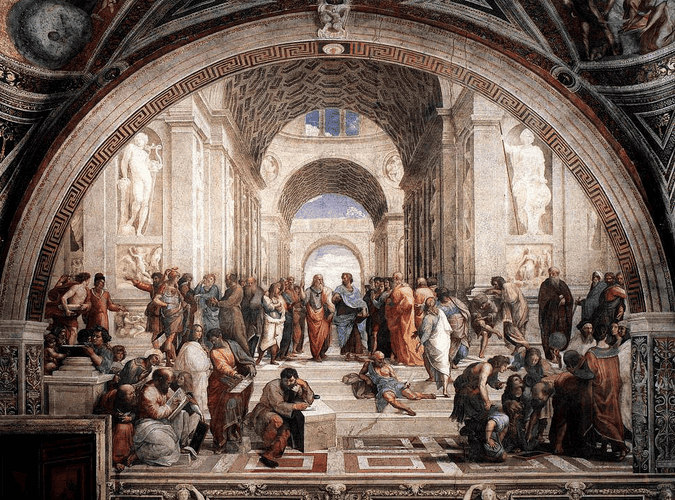Aristotle, the famous Greek philosopher, allegedly used to walk while lecturing. Since he was not a citizen of Athens, he could not own property. Like another famous philosopher, Socrates, he and his colleagues used the grounds of the Lykeion (Latin Lyceum ), the name of a gymnasium dedicated to Apollo Lyceus (the term lyceus was applied to the type of statue that represented Apollo with his arm resting on his head).
This happened around 335 B.C. and the Lyceum actually became an informal institution where Aristotle’s followers conducted philosophical and scientific inquiries, rather than being a formal school. Nevertheless, those followers were known as the Peripatetic school (the Greek word περιπατητικός [ peripatêtikos ] meant “given to walking about”), and Aristotle’s school came to be named Peripatos because of the peripatoi (“covered walkways”) of the Lyceum.
The word lyceum entered many languages, like English and Armenian, where sometimes the word Լիկէոն ( likeon ), used to translate Aristotle’s Lyceum, has been used to denote the high school section of a school. This happened, for instance, in the case of a famous Mekhitarist school, the Mourad-Raphael school of Venice, which existed from 1836 to the 1990s.
However, the Armenian language found a way to give the concept of “lyceum” (or “Academy,” as Aristotle’s teacher Plato called his own school) with a word of its own. Following the idea of the peripatetic school, it used the root ճեմ ( jemel “walk”), derived from an Iranian source, from which derived ճեմարան ( jemaran “walking place”). In the eleventh century, the word was also used to call the schools founded by another important writer, Grigor Magistros, in Ani, Sanahin, and Bjni. Later on, the school of the monastery of the Holy Cross, in Crimea (fourteenth-seventeenth centuries) received the name of jemaran.
In the nineteenth and early twentieth centuries, several important educational institutions took the name of jemaran, meaning “academy” or “lyceum,” such as the Lazarian Academy of Moscow (1814-1918), the Scutari Lyceum in Constantinople (from 1838), the Gevorgian Lyceum in Etchmiadzin (1874-1917), the Academy of Marash (1891-1915), the Cilician Lyceum of Aintab (1891-1915), and others. The name was continued in Armenia when the Seminary ( հոգեւոր ճեմարան/hokevor jemaran ) of Etchmiadzin was reopened in 1945. However, it was more consistently used in the Diaspora. For many decades, the name Jemaran became synonymous with the school founded in Beirut (1930) by the Hamazkayin Armenian Cultural and Education Society, first known as “Armenian College,” then as “Nshan Palanjian College,” and currently as “Melanchton and Haig Arslanian College” (the word college is used in the French and not the American sense of the word). Nevertheless, other jemarans had existed before, such as the Mesrobian Academy in Sofia (1921), and later, such as the Karen Jeppe College (1947) and the Cilician College (1960), both in Aleppo, for instance.
On a side note: for decades, the Armenian American community did not have a daily school of its own, thinking that it was not important for its survival. It used to think that it was more important to do fundraisers to benefit “the” Jemaran, the one in Beirut. This went on and on until the 1960s, when a new generation arrived in this country, conscious of the importance of Armenian daily schools to ensure not only the future of the Armenian language in the United States, but also of the community. Then, the fundraisers continued, but with a different goal.

